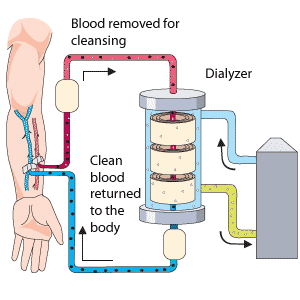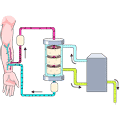Description of the procedure
The kidneys remove waste, salts, and excess water from the blood. If the kidneys do not work normally, a hemodialysis machine can perform these functions. People with chronic or acute kidney failure (permanent loss of kidney function) need dialysis on a permanent, regular basis.
In emergency situations, hemodialysis helps remove toxic drugs or poisonous chemicals from the blood quickly.
Hemodialysis usually takes place in a dialysis centre in a hospital, in a specialized clinic, or at home.
When should this procedure be performed?
The length of each dialysis treatment and how many treatments you need per week depend on the type of hemodialysis you are receiving. For example, people receiving hemodialysis from a dialysis centre will receive 3 treatments a week, lasting 3 to 5 hours each. You and your doctor should discuss which schedule and environment best suit your needs.
Why is this procedure performed?
When the kidneys no longer function properly, they cannot remove excess water, salts, and waste from the blood. Hemodialysis provides a method of "cleaning" the blood. Otherwise, substances such as salt, potassium, and urea may reach levels that may damage the body and cause fluid accumulation and high blood pressure.
Transplanting a kidney is an alternative to dialysis; however, if the intended recipient is not healthy enough to undergo a major operation, or if a suitable organ cannot be found, a transplant may not be possible.
Are there any risks and precautions?
Although a hemodialysis is generally considered safe, it does have some risks of side effects or complications. These include:
- anemia
- bleeding at the site where blood leaves and re-enters your body (the access point)
- infections or blood clots where the dialysis machine is connected to your body
- low blood pressure due to a rapid decrease in the amount of water in your blood
- cramping muscles
- changes in your heartbeat
- headache, nausea, vomiting, or confusion
- itchy skin during or right after the dialysis
- trouble sleeping
- bones weakened by too little vitamin D (a vitamin made by the kidneys)
As part of your overall treatment, a dietitian will help you to come up with a meal plan that manages your intake of fluids and nutrients (e.g., protein, salt, potassium) to accommodate your individual needs.
To minimize complications related to hemodialysis, follow your dietitian's guidelines and take any medication as directed.
If you are concerned about any symptoms following this procedure, speak to your doctor. Take the time to be sure you understand all the risks of complications and side effects as well as any precautions you or your doctor can take to avoid them. Be sure your doctor understands all your concerns.
What happens during the procedure?
The procedure is usually done in a clinic or hospital, but may be done at home after you are trained.
First, the hemodialysis machine is attached to your bloodstream by inserting a needle into three possible places: directly into a blood vessel using a plastic catheter (this is more common for emergency hemodialysis), into a fistula, or into a graft.
A fistula is created by surgically attaching a vein and an artery together to increase blood flow into the vein, making it larger and stronger. This larger and stronger vein is easier to connect to the dialysis machine and perform repeated hemodialysis treatments.
A graft is used when the artery and vein can't be connected directly. A nylon tube is used instead with one end connected to the vein and the other to the artery. You may feel some pain when the needle is inserted.
Most dialysis treatments involve two needles: one to carry the blood to the dialyzer and one to carry the blood back to the body. Sometimes, one needle that has two openings is used.
Your blood passes through the dialysis machine a small amount at a time. In this machine is a filter called a dialyzer, which is made up of two chambers (one for blood and one for dialysis fluid) separated by a membrane. As blood passes through the dialyzer, waste materials and excess water are drawn through the membrane and absorbed by the dialysis fluid. Your blood re-enters your body and the dialysis fluid is later discarded.
How should I prepare for this procedure?
Before having this procedure, discuss the advantages, disadvantages, long-term risks, and consequences associated with the procedure with your doctor. Be sure you fully understand what will happen and are comfortable with your doctor's answers to your questions.
For ongoing hemodialysis treatments, you will likely need to have a fistula or graft inserted into your arm. These provide faster and easier access to your bloodstream and are usually prepared several weeks to a few months before your first dialysis treatment.
Tell your doctor or prescriber about all prescription, over-the-counter (non-prescription), and herbal medications that you are taking. Also tell them about any medication allergies and medical conditions that you may have.
Ask your doctor or pharmacist whether you need to stop taking any of your medications before the procedure.
What can I expect after the procedure?
Between visits for hemodialysis, maintaining a certain diet is important to minimize a buildup of waste and water in your blood. Working together with your doctor and a dietitian, you can learn how to make the best choices to remain healthy.
Results
Hemodialysis helps filter wastes and excess water from your blood. This may help improve your quality of life and life expectancy, and can also keep you healthy while you wait for a kidney transplant. Your dialysis team will check your blood regularly to make sure your treatments are removing enough excess water and waste products from your blood.
All material copyright MediResource Inc. 1996 – 2024. Terms and conditions of use. The contents herein are for informational purposes only. Always seek the advice of your physician or other qualified health provider with any questions you may have regarding a medical condition. Source: www.medbroadcast.com/procedure/getprocedure/Hemodialysis


